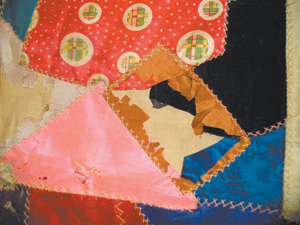AROUND THE FRAME
 WHEN NOT TO USE VINTAGE FABRIC-PART TWO
WHEN NOT TO USE VINTAGE FABRIC-PART TWO
19th century silk
Ahh the Victorian Age, the mid-to late 1800s! Think Scarlett O’Hara and her lavish ball gowns. Think of the Victorian crazy quilt craze that peaked in the last quarter of the century. Made up of pieces of taffeta, brocade, satin, velvet and silk, they are often lavishly decorated with embroidery. You can easily spot the quilts from this era: They are the ones with shredded pieces of silk barely attached to the quilt.
Why, you ask, are the silks from this era in such terrible condition when silks 50-100 years older are in better condition?
This is the story of a perfect storm. During this time period, fabric was sold by weight, not length. At the same time, women wanted their silk gowns to rustle as they paraded around. So enterprising manufacturers weighted down the silk with metallic salts, creating more rustle, adding more weight to the fabric, adding more money to their pockets, and selling fabric that would flake and rot!
In 1906 the Pure Food and Drug Act was passed due to Upton Sinclair’s novel The Jungle which exposed the unsanitary conditions of Chicago’s stockyards. Soon to follow was legislation banning the practice of weighting fabric.
Editor’s Note: On Super Bowl XLVI Sunday, February 7, once you are finished reading the sports page, page through to the Metro Section with Journal Gazette reporter Joyce McCartney’s interview with Lois.
- Sewing For A Higher Purpose ~ Around The Frame - April 12, 2024
- National Quilting Day 2024 ~ Around The Frame - March 1, 2024
- Reunited! ~ Around The Frame - February 2, 2024


